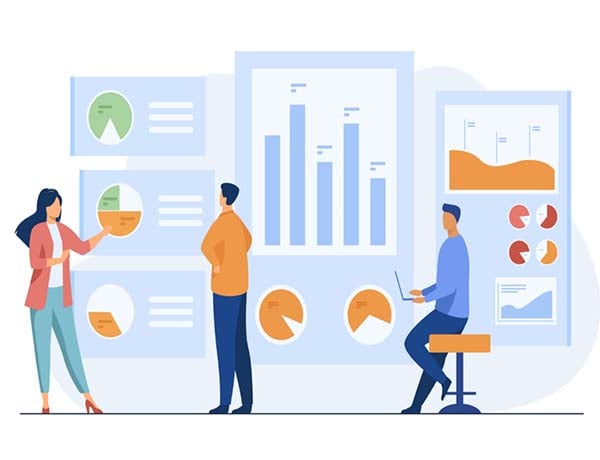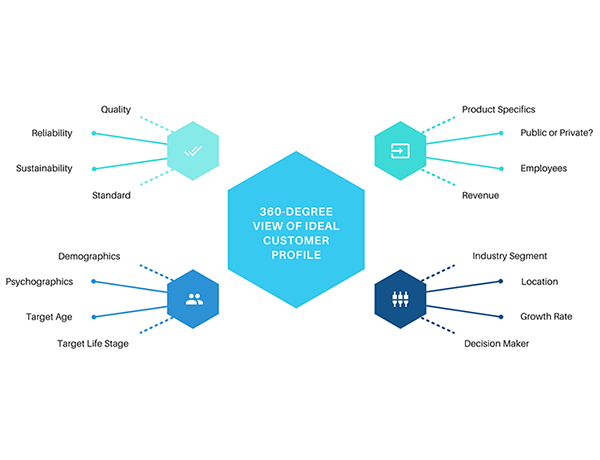What is Email Open Rate?
Email open rate is the overall count of subscribers who has opened the email. Your email open rate provides insight into how effective your email marketing campaign is. It is ideal to see if your readers are attracted to your emails. Email open rates are an effective way to check if your email campaign needs to be altered.
Factors influencing Email Open Rate Outcomes
Several elements come into play when determining whether or not an email will capture the interest of your audience. Relevance of your emails to your subscribers, urgency, word count, and the time of day you send them are just a few of these considerations. These characteristics will also influence whether or not your recipients will open your emails. However, the following are the topmost essential factors that influence your email open rate:
1. Significance towards your Targeted Audience
Subscribers have specific desires and requirements. They are divided into several groups and are motivated by a wide range of interests. The quality of the information in your emails is the limiting element when it comes to email open rates. Sending an email to your list with stale or irrelevant material will result in your emails being ignored. One of the reasons your email ends up being reported as spam is if you send out emails that are of no use to the people on your list. As a result, it's critical to focus on a specific set of people interested in what you have to offer.
2. Email Content
Checking if the email marketing messages are relevant to the user is essential. The emails need to be focused on the content the subscribers look forward to. The emails should be personalized in a meaningful and captivating manner to ensure they are opened and read thoroughly. This strategy helps avoid hard email bounces as well.
3. The capacity of Email Lists
You can be confident that if you can persuade your visitors to join your email list, they are at least moderately interested in what you have to offer. Convincing them to sign up for emails, on the other hand, is a surefire method to have your emails ignored, discarded, or reported as spam.
4. The Right time to send Emails
Depending on their schedules, some people prefer to check their emails in the morning, afternoon, or evening. Choosing an appropriate time to send emails can be tricky because there is no one-size-fits-all solution. So, experiment with sending emails at various times of the day to see what works best for you, and then stick to it.
5. ptivating Subject lines
More than a third of your subscribers decide whether or not to open an email based just on the subject line's attractiveness. Your subject line is your first, sometimes only, chance to attract the attention of your subscribers and pique their interest in learning more. Pay attention to your subject line, as it accounts for your email open rates. Your subject line should be brief, but it should provide enough information about the email content. Emails must be capable of keeping your subscriber attentive to the content from the moment they open it.
Bonus Tip
The actual task of sending marketing emails is to get your subscribers to open the email. Here are five email subject lines to improve your open rate at one glance and captivate your prospects:
- Targeted Subject Lines
- Subject Lines that peek Curiosity
- Subject Lines with Humor
- Subject Lines promoting Offers
- Surprising Subject Lines
25 Email Segmentation Tricks to Enhance your Email Open Rates
1. Subscription Preferences
Ask your potential client how often they want to get emails from you, and give them the option of choosing which types of emails they'd like to receive. Present the options like receiving emails for discounts, blogs, important updates, offers, articles, or all of them. Make sure you offer a chance to update the subscription frequency, increasing the customer retention rate.
1. Subscription Preferences
Ask your potential client how often they want to get emails from you, and give them the option of choosing which types of emails they'd like to receive. Present the options like receiving emails for discounts, blogs, important updates, offers, articles, or all of them. Make sure you offer a chance to update the subscription frequency, increasing the customer retention rate.
2. Email Engage Rate
Building an email list isn't enough; segmentation is also needed. When your emails are continuously tailored particularly to their needs, you boost the relevancy of your emails to your subscribers. Use behavioral data such as browser history to segment your email list in addition to demographic data like age, geography, gender, and so on. Use open rate data to segment your subscribers into prospects who open your emails frequently and those who don't open your emails. You can reward your most active subscribers by providing exclusive offers and discounts.
3. Reconnect with Inactive Subscribers
Check for inactive users and notify them regarding your subsequent updates with exciting email messages to peek their interest. You could send a targeted email to subscribers who have been inactive for a long time to check if they still want to hear from you or would like to unsubscribe. You can also remove subscribers who have been inactive for an extended period of time. With this approach, you can keep your B2B marketing list fresh with active email contacts.
4. Create Excitement
Benefit from the subscribers thought of "Fear of Missing Out." This can be accomplished by delivering high-value material or special offers. This can necessitate consistency, but it will make your subscribers eagerly anticipate your upcoming emails.
5. Resend Unopened Emails
Your email open rate may be low because your subscribers failed to detect your emails in their inbox. A lousy subject line is generally to blame. Resending these emails with a new subject line is one method to alleviate this gloom. It's that simple.
6. Resolve your Subscriber Issues
Find out what your audience's problems are and offer solutions. Pictures, videos, and quizzes are all excellent learning tools. However, you should strive to include some practical problem-solving advice. To begin, discover challenges that are specific to your niche and create content that addresses these issues. Make the guidelines constant, and you'll be well on your way to raising your email open rate.
7. Segment with Lead Magnet type
The subscription category of each user varies based on their lead magnet type. Some prefer to read PDF reports, whereas others want to attend live webinars. Categorizing your target audience according to your lead magnet with opt-in contacts, you can offer the type of content they seek and desire to improve the open rate.
8. Maximum Purchase Count
By segmenting your consumers based on the amount of purchase, you can provide them with a relevant offer or discount. You can also give special treatment to consumers who make substantial purchases by giving them a free voucher or some other incentive to reassure them that buying from you was a wise option.
9. Level of Customer Satisfaction
When purchasing another product or when a new subscriber arrives, ask: "How likely are you to suggest us to a colleague or friend on a scale of 0 to 10?" Categorize your audience with the criteria of Low score between 0-6, Medium score between 7-8, and High score between 9-10. This gives a clear perspective to segment your email lists based on the scores.
10. Buying Process
Certain purchases follow a predictable pattern: they are seasonal or occur at specific times. Your email marketing initiatives can be guided by knowing where your consumers are in their purchasing cycle. Based on their purchase cycle timeline, you can send a reminder to purchase the product, which creates an alert regarding their topic of interest.
11. Sales Process Levels
The next email you send should be tailored to the level of each subscriber in your sales funnel. It is vital to foster new subscribers. Warm leads need to be prepped before being sold. Offers and promotions must be made available to potential customers. Every stage should have its own email marketing campaign to promote it.
12. Changes in Buying Habits
Customers should be contacted according to their changing purchase habits. Especially if you offer a monthly subscription or have a product that needs to be purchased regularly. If a consumer cancels their subscription, you should write them an email and ask why. Even if you don't hear back from that consumer, their response will help you enhance the user experience for future customers.
13. Email Account Type
You can segment your email design based on your different email clients to simplify the marketing process. However, interpolating what other services your members have and their email provider may better use this segmentation.
14. Subscribers Who Have Recommended You
You have subscribers who have told their friends about you; give these subscribers a distinctive tag to value them with extra attention. Once these subscribers have been labeled, you can send them a special thank you voucher or VIP access, an exclusive discount that no one else has. Acknowledge them on how grateful you are for their efforts in spreading the word about your product or service, and they will repay you with customer loyalty.
15. Employment Title
Segment your audience based on specific job titles. Every job title has a different pain point that needs to be addressed individually. A categorized email list leads to a potentially successful marketing plan to personalize your campaigns.
16. Customer Profile
There are multiple buyer personas in most firms. These personalities have varying needs and respond to diverse copy. You can develop customized email lists according to your subscribers opt-in data, the content that has open rates for your email campaigns, and their behavior on your website. Create segments for each client profile using the information gathered thus far.
17. Birthday Category
Birthday segmentation is a wonderful touch that makes your subscribers feel special. You can interact with customers on a much more personal level by sending them tailored emails with special offers or just a simple happy birthday letter.
18. Level of Skills
It is essential to know how skilled is your subscriber based on levels such as beginner, reasonably proficient, or advanced user. Depending on the ability level of your audience, the content you deliver to them can vary substantially. Knowing how to communicate with them can be incredibly beneficial to your marketing.
19. Psychographics Data
Psychographic data are user traits like interests, personality, lifestyles, opinions, values, attitudes, and so on. Targeting emails to the ideal audience is effective and much easier if you already know the specific subscriber details. You can collect your users data from the lead magnets database and create the ideal customer profile. Then send personalized emails to show interest in their business needs.
20. Industry-specific Segmentation
Categorize your email database according to the specific business industry to alert your users of any new updates and offers on the new release of email lists and updates that are available. You can modify your email content to be highly relevant to your readers if you acquire industry information about them. For instance, if you wrote a blog post about how to market your business. You can send one email to your real estate industry subscribers explaining how this blog article will assist them in gaining more customers while advertising that blog post to your email list. You can write a follow-up email to the restaurant owners in your list explaining how your blog article will help them attract more clients, and so on.
21. Prospects who Attended the Webinar
Segment subscribers who signed up for a webinar into groups based on whether or not they attended the webinar. You can re-engage individuals who were unable to attend by offering them the opportunity to register for the webinar reboot. You can also give them a quick summary of what they missed. You can even divide your webinar participants into groups based on how long they stayed on the call. Those who stayed for the entire presentation could receive a unique bonus code or offer, while those who leave early can be sent a survey regarding why they had to leave or lost interest.
22. Gender
You can easily direct your campaigns to the categorized database if you have varying lists based on the specific demographic data point. Some products and services are ideal for the targeted gender with a personalized email message to meet the subscribers needs and remain relevant to the marketing emails.
23. Income Category
It is ideal for segmenting your users, depending on their current income. For example, certain subscribers require different types of information. If you have a lot of small business owners among your subscribers, one group might be interested in learning how to build their 5-figure firm into a 6-figure business. Another group would be interested in learning how to increase their income from 6 to 7-figures. Another group could just be interested in learning how to make their first 3K profit per month. Segmenting helps with personalized targeting to boost the open rate.
24. Education Level
In some circumstances, segmenting based on educational attainment makes sense. For instance, if you're an educational institution, you might need to deliver different information and promotions to subscribers with a High School graduation versus those who have a Bachelor's degree and are considering pursuing a Master's. As a result, marketing messages vary according to the industry needs and the specific business needs with multiple factors.
25. Career Level
The category-based on jobs can be help professionals such as recruiters, coaches, and more. They can be grouped like subscribers looking for a job, users looking for a job change, and subscribers looking for a senior job role. Based on specific business needs, you can categorize your lists further.
To Wrap It Up!
You are presented with the resultant strategies for email segmentation to enhance your email open rates with a personally devised email marketing campaign approach. The process of filtering and verifying your mailing list that holds new and active email contacts can be elongated when the investment of time and resources comes into play. A segmented and processed B2B email list can be purchased at a pocket-friendly price from AverickMedia, which offers multiple data segment options along with a real-time updated database. Buying email contacts from a reliable data vendor ensures responsive contacts with a time-efficient approach.



































